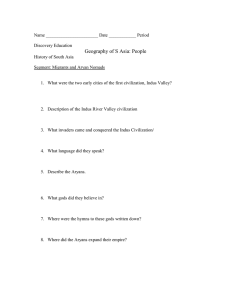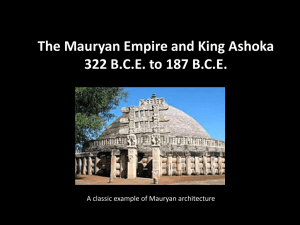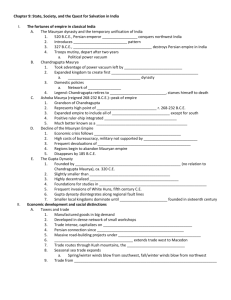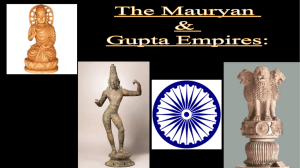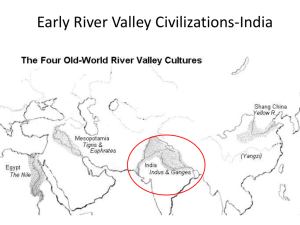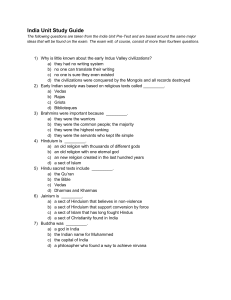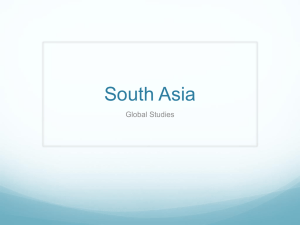Shivani Sanghani 1/15/13 AP World History Pd. 3 Midterm Review
advertisement
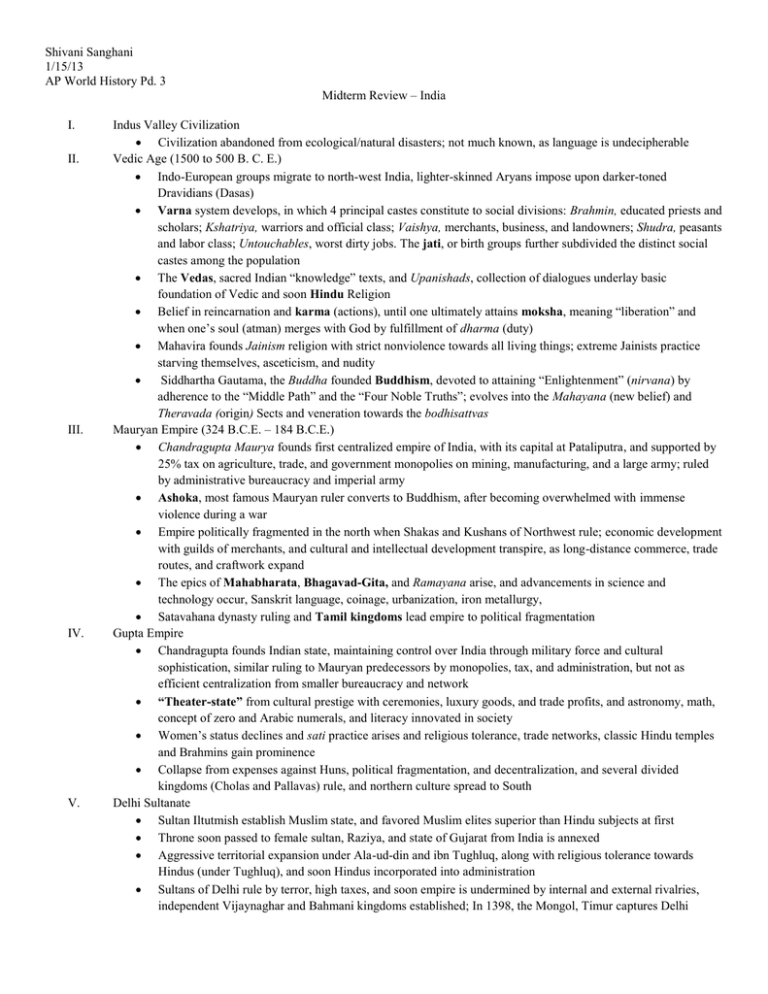
Shivani Sanghani 1/15/13 AP World History Pd. 3 Midterm Review – India I. II. III. IV. V. Indus Valley Civilization Civilization abandoned from ecological/natural disasters; not much known, as language is undecipherable Vedic Age (1500 to 500 B. C. E.) Indo-European groups migrate to north-west India, lighter-skinned Aryans impose upon darker-toned Dravidians (Dasas) Varna system develops, in which 4 principal castes constitute to social divisions: Brahmin, educated priests and scholars; Kshatriya, warriors and official class; Vaishya, merchants, business, and landowners; Shudra, peasants and labor class; Untouchables, worst dirty jobs. The jati, or birth groups further subdivided the distinct social castes among the population The Vedas, sacred Indian “knowledge” texts, and Upanishads, collection of dialogues underlay basic foundation of Vedic and soon Hindu Religion Belief in reincarnation and karma (actions), until one ultimately attains moksha, meaning “liberation” and when one’s soul (atman) merges with God by fulfillment of dharma (duty) Mahavira founds Jainism religion with strict nonviolence towards all living things; extreme Jainists practice starving themselves, asceticism, and nudity Siddhartha Gautama, the Buddha founded Buddhism, devoted to attaining “Enlightenment” (nirvana) by adherence to the “Middle Path” and the “Four Noble Truths”; evolves into the Mahayana (new belief) and Theravada (origin) Sects and veneration towards the bodhisattvas Mauryan Empire (324 B.C.E. – 184 B.C.E.) Chandragupta Maurya founds first centralized empire of India, with its capital at Pataliputra, and supported by 25% tax on agriculture, trade, and government monopolies on mining, manufacturing, and a large army; ruled by administrative bureaucracy and imperial army Ashoka, most famous Mauryan ruler converts to Buddhism, after becoming overwhelmed with immense violence during a war Empire politically fragmented in the north when Shakas and Kushans of Northwest rule; economic development with guilds of merchants, and cultural and intellectual development transpire, as long-distance commerce, trade routes, and craftwork expand The epics of Mahabharata, Bhagavad-Gita, and Ramayana arise, and advancements in science and technology occur, Sanskrit language, coinage, urbanization, iron metallurgy, Satavahana dynasty ruling and Tamil kingdoms lead empire to political fragmentation Gupta Empire Chandragupta founds Indian state, maintaining control over India through military force and cultural sophistication, similar ruling to Mauryan predecessors by monopolies, tax, and administration, but not as efficient centralization from smaller bureaucracy and network “Theater-state” from cultural prestige with ceremonies, luxury goods, and trade profits, and astronomy, math, concept of zero and Arabic numerals, and literacy innovated in society Women’s status declines and sati practice arises and religious tolerance, trade networks, classic Hindu temples and Brahmins gain prominence Collapse from expenses against Huns, political fragmentation, and decentralization, and several divided kingdoms (Cholas and Pallavas) rule, and northern culture spread to South Delhi Sultanate Sultan Iltutmish establish Muslim state, and favored Muslim elites superior than Hindu subjects at first Throne soon passed to female sultan, Raziya, and state of Gujarat from India is annexed Aggressive territorial expansion under Ala-ud-din and ibn Tughluq, along with religious tolerance towards Hindus (under Tughluq), and soon Hindus incorporated into administration Sultans of Delhi rule by terror, high taxes, and soon empire is undermined by internal and external rivalries, independent Vijaynaghar and Bahmani kingdoms established; In 1398, the Mongol, Timur captures Delhi
